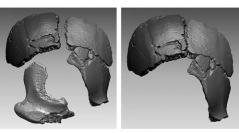

 Comptes Rendus Palevol
11 (2-3) - Pages 89-95
Comptes Rendus Palevol
11 (2-3) - Pages 89-95Few human fossils are known in Turkey and no Homo erectus has been discovered until now. In this respect, the newly discovered partial skull from Kocabaş is very important: (1) to assess the pattern of the first settlements throughout the Old World; and (2) to document the extension of the species H. erectus to the west of continental Asia. Using CT data and 3D imaging techniques, this specimen was reconstructed and a more detailed analysis was done, including the inner anatomical features. The preliminary results of this study highlight that the fossil hominid from Kocabaş is close to the H. erectus species regarding the following cranial patterns: presence of a clear post-orbital constriction, strong development of the frontal brow-ridge with a depressed supratoral area in the lateral part, as well as endocranial patterns such as the development and orientation of the middle meningeal artery and the presence of a frontal bec. The Kocabaş skull is morphologically very close to the fossils from Zhoukoudian L-C. The partial Kocabaş skull is the oldest H. erectus known in Turkey and the only one from this species to have settled so far west in Asia.
Homo ergaster, Homo georgicus, First settlements, 3D imaging techniques, Morphometrics, Inner anatomical features, Turkey